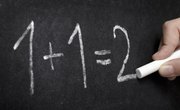Using a project-based approach for teaching the order of operations to young math students allows them to practice and show their knowledge of math facts in an interesting way. As students create their projects, they use the procedures they have learned in class to demonstrate the order of operations in action or explain the process to an audience.
Calendar Project
Assigning a project based on the current month’s calendar allows students to delve into using the order of operations coupled with their problem-solving skills to work backward and find equations to go with a provided answer. The goal of the project is for students to write equations using multiple numbers and operations to result in the number of each day in the month.
For example, for November 12, the student would create an equation that equals 12. Students may come up with (1 + 6) + 10 - 5 and write this equation along with the steps for solution in that calendar space. Provide criteria for the amount of numbers or steps you would like in each equation and limiting the use of numbers one and zero.
Informational Brochure
By creating an informational brochure about the order of operations, students not only work through problems providing examples, but also explain the steps for using the order of operations. Assign a brochure project in which students fold a piece of paper into a tri-fold and create an appealing document that could help someone learn about the order of operations. You may want to assign criteria for what should be in each of the sections, such as a detailed explanation of each step, a way to remember the steps, examples of equations solved using the order of observations, and a statement of why using the order of operations is important.
Mobile Operations
Creating a mobile is a fun way for students to highlight the step-by-step process of solving a multi-step equation using order of operations. Students begin at the top of the mobile with an equation using various operations and groupings. To create each subsequent layer, students use the order of operations to simplify the equation step by step on strips of paper. Students assemble them using a coat hanger and string with the original equation at the top, the steps to solve in the middle and the answer at the bottom.
For example, if the top layer was 3 x (5 + 8), the layer underneath would be 3 x 13. Hanging the mobiles up in the classroom reminds the students to approach these problems one step at a time and work their way down until they find the answer.
Room Number Poster
As students take on a project to create posters labeling the classrooms in their school or hallway, they practice using the order of operations and writing equations to arrive at a specific answer. Give each student a different classroom number as the answer they must arrive at. Provide criteria for the number of steps that the equation should entail, and make it a requirement to use all of the operations. Students create a poster showing the steps of the order of operations they use to arrive at their assigned classroom number. When finished, students may enjoy displaying their work throughout the school.
Related Articles
References
Writer Bio
Anne Post has experience teaching in both public and private school settings, as well as several early childhood programs. Post holds a Bachelor of Science in education from the State University of New York at Geneseo with expertise in both childhood education and special education.










